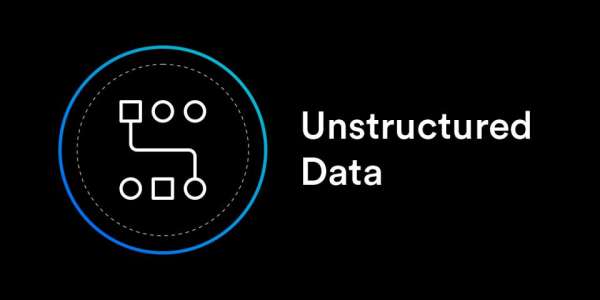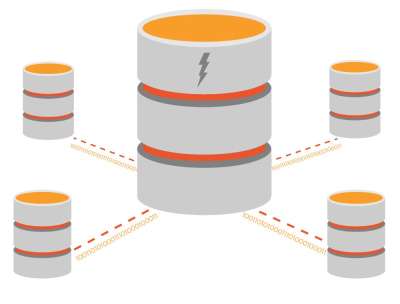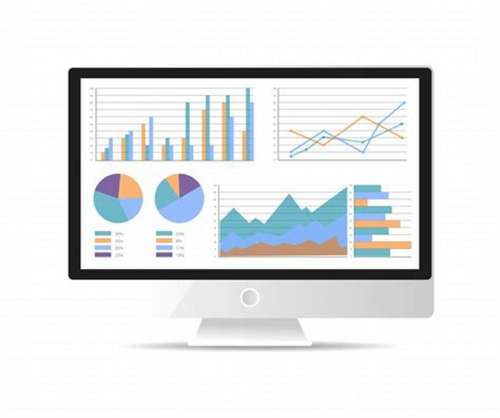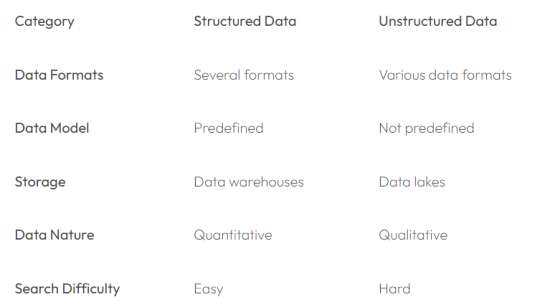Understanding Unstructured Data

In a world that’s continually embracing digitalization, data abundance is the norm. Much of the online content comprises unstructured data, spanning diverse formats and structures.
Unstructured data encompasses a wide array of information types found online, including audio files, text data, social media content, sensor readings, video files, business documents, and more.
But what exactly is unstructured data, and how can organizations leverage it to accomplish their objectives effectively?
Today, we’ll delve into unstructured data, examining its nuances, advantages, and distinctions from structured data.
Let’s get started!
Jump To...
An Introduction to Unstructured Data
Unstructured data refers to information that lacks a predefined format. While it may possess an internal structure, unstructured data does not adhere to a predefined data model.
Typically, unstructured data is found in large datasets, often referred to as unstructured datasets. These datasets consist of big data files that are not organized in a traditional row-column database format.
Unstructured data can originate from human-generated sources or be generated by machine learning algorithms. This data can manifest in various forms, including both non-text and text files.
To analyze unstructured data effectively, database administrators typically need to extract raw data from its source. Data analysts often rely on business intelligence tools to analyze unstructured data and help achieve the company’s objectives. These tools provide functionalities for processing, organizing, and deriving insights from unstructured data, enabling organizations to make informed decisions based on the analysis.
Instances of Unstructured Data
Indeed, numerous types of unstructured data lack a predefined structure. Here are some common examples:
- Social media posts
- Log files
- Customer data
- PDF documents
- Social media chat data
- Weather data
- Atmospheric data
- Artificial intelligence (AI) data
- Machine learning (ML) data
- Invoices
- Scientific data

Strategies for Effectively Analyzing Unstructured Data
Unstructured data analytics encompasses various methods, with standard approaches including:
- Unstructured text data mining: This method utilizes natural language processing (NLP) to extract valuable insights from textual data. For instance, businesses can leverage this technique to analyze customer behavior by examining reviews across social media platforms, identifying patterns, and understanding customer sentiments.
- Sentiment analysis: Companies can conduct sentiment analysis to discern customer emotions from text-based sources. This business intelligence tool enables organizations to gauge whether customers express positive or negative sentiments about specific products or services, aiding in decision-making and customer satisfaction efforts.
- Machine learning: Employing machine learning algorithms enables businesses to uncover actionable insights from customer data. Analytics tools incorporating machine learning can analyze customer behavior, identify trends, and provide predictive insights, empowering organizations to make informed decisions and enhance performance.

Businesses and individuals often store unstructured data in non-relational databases such as Hadoop or NoSQL. These databases are specifically designed to handle large volumes of unstructured data efficiently.
Furthermore, non-relational databases are optimized for managing unstructured data, offering flexibility and scalability for diverse data types and formats.
Unstructured data is typically stored in various formats, including:
- Text files, such as PDFs and emails
- Image files, including JPEGs and PNGs
- Audio files, such as MP3s and WAVs
- Video files, including MPEGs and AVIs

What does Structured Data refer to?
Structured data typically refers to quantitative data stored in a relational database, also known as an RDBMS.
In structured data models, each data element is associated with form fields, enabling the identification of individual pieces of information.
Common examples of structured data include phone numbers, zip codes, names, addresses, credit card numbers, stock information, and other easily searchable information.
Organized and Unorganized Data
The primary distinction between structured and unstructured data lies in their formatting and organization.
Organized Data
Structured data is indeed predefined and organized into tables with rows and columns. Analyzing structured data is generally easier because searching and locating data within a relational database is straightforward.
Structured data can be likened to well-organized records or transactions stored in spreadsheets within a relational database environment.
Disorganized Data
On the contrary, unstructured data lacks predefined organization, and its storage operates differently compared to structured data.
Indeed, unstructured data is typically stored within large datasets containing various types of files and information, all intermingled without clear segregation.
Therefore, successful analysis of unstructured data necessitates expertise, as processing unstructured data is inherently more challenging.
Indeed, managing unstructured data poses difficulties because diverse information like product catalogs, financial records, and social media files are all mixed together and lack the clear organization found in structured data.
Fortunately, there exists a plethora of unstructured data analytics tools available to data administrators. These tools enable the management of unstructured data and enhance the efficiency of business processes.

Applications of Organized and Unorganized Data
Certainly, the substantial disparity between structured and unstructured data renders each suitable for distinct purposes.
Examples of Organized Data Applications
Structured data finds utility across diverse industries, spanning accounting, financial services, banking, ATM networks, and reservation systems.
Moreover, structured data proves invaluable for businesses leveraging customer relationship management platforms (CRMs). Its ease of handling allows companies to swiftly access client information, facilitating rapid report generation and efficient data analysis.

Examples of Unorganized Data Applications
Indeed, the versatility of unstructured data allows for a multitude of applications. The various unstructured data types stored in non-relational databases prove invaluable for data mining, aiding businesses in gathering extensive insights into customer behaviors, purchasing habits, and market trends.
Furthermore, businesses that analyze unstructured data can leverage the collected information to forecast future market shifts, enhancing their ability to plan and prepare for upcoming developments effectively.
Moreover, unstructured data holds significant potential for creating Chatbots. Leveraging natural language processing and AI, businesses can extract information from diverse sources and utilize it to craft responses that mimic human conversation, providing users with a more engaging and natural chat experience.

Advantages and Disadvantages of Organized and Unorganized Data
Understanding the strengths and weaknesses of structured and unstructured data can streamline operations by guiding you to the most suitable data sets for specific tasks, saving time and enhancing efficiency.
Advantages and Disadvantages of Structured Data
Advantages
- Simplified analysis: Structured data facilitates easier analysis through structured query language (SQL), enabling established queries for information retrieval. The resulting reports are straightforward, ideal for data-driven decision-making.
- Consistency: Predefined structure ensures uniformity across file systems, simplifying data management.
- Swift processing: Organization into tables and spreadsheets expedites sorting and filtering, streamlining data processing.
- Seamless integration: Structured data allows smooth sharing and utilization across systems, enhancing efficiency in integration with databases and applications.
Disadvantages
- Limited flexibility: Confinement to predefined formats restricts usability, particularly for businesses handling diverse data types.
- Manual entry: Structured data often necessitates extensive manual data input, which can be laborious and costly.
- Higher expenses: Implementation and maintenance of structured data can incur substantial costs, especially when specialized tools and systems are required.
- Data incompleteness: Irregular updates may lead to incomplete data, potentially resulting in inaccurate analyses and decisions due to inadequate information availability.
Advantages and Disadvantages of Unstructured Data
Advantages
- Versatile applications: Unstructured data, stored in its native format, lends itself to interpretation across diverse applications, offering flexibility in usage.
- Rapid data acquisition: Absence of predefined parameters enables swift information gathering, facilitating valuable insights extraction from various sources like social media posts and reviews.
- 3. Scalability: Storage in onsite or cloud data lakes allows for high scalability, with the ability to expand storage capacity as needed for larger unstructured data volumes.
- Competitive edge: Despite the analytical challenges posed by larger unstructured data volumes, effective analysis can provide a competitive advantage by offering superior insights and identifying customer trends.
- Enhanced customer service: Conducting sentiment analysis on social media posts and reviews enables improved customer service and fosters customer retention.
Disadvantages
- Analytical complexity: Unstructured data’s open-ended nature requires interpretation, making analysis more challenging and potentially necessitating expert assistance for informed decision-making.
- Limited analytics tools: Compared to structured data analytics, there are fewer available tools for unstructured data analysis, limiting analytical capabilities.
- Indexation challenges: Unstructured data’s lack of predetermined structure complicates and lengthens the indexation process, making it prone to errors and requiring additional effort.
A Summary of the Primary Contrasts Between Structured and Unstructured Data

Understanding unstructured data, its capabilities, and its utilization is paramount, particularly in today’s landscape where the majority of shared information lacks structure.
Furthermore, the ubiquitous nature of unstructured data furnishes businesses and individuals with limitless reservoirs of information. Leveraging this wealth of data enables entities to enhance their brand presence and cultivate superior user experiences for their customers.
Moreover, unstructured data is experiencing unprecedented growth rates, surpassing those of structured data.
Therefore, integrating unstructured data analysis into your business operations empowers you to leverage the insights and information gathered, gaining a competitive edge that distinguishes you from competitors.
Frequently Asked Questions
Indeed, unstructured data encompasses various formats aggregated and stored in a non-relational database.
Furthermore, unstructured data lacks predefinition, indicating it does not adhere to a predetermined data model for segregating files based on their type.
Unstructured data exhibits diverse forms and formats. Some prevalent examples of unstructured data include:
- Social media posts
- Human-generated queries
- Machine-generated queries
- Sensor data
- Business documents
- Media files
- Text data
- Emails
Businesses and individuals leverage unstructured data analysis to glean insights from diverse sources.
By extracting and analyzing this data, they can gain valuable insights into customer behavior, purchasing trends, and market dynamics. This information empowers them to refine their marketing strategies and enhance the positioning of their products and services, thereby strengthening their competitive edge.




